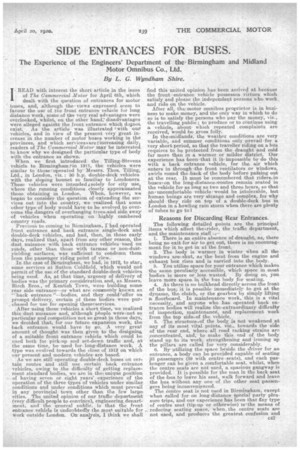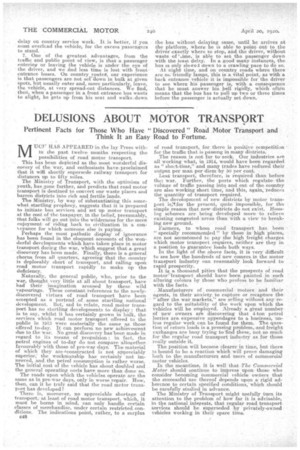SIDE ENTRANCES FOR• BUSES.
Page 19

Page 20

If you've noticed an error in this article please click here to report it so we can fix it.
The Experience of the Engineers' Department of the, Birmingham and Midland Motor Omnibus Co., Ltd.
By L. G. Wyndham Shire.
I READ with interest the short article in the issue
of The Commercial Motor for April 6th, which dealt with the question of entrances for motor buses, and, although theviews expressed seem to favour the use of the front entrance vehicle for long distance work, some of the very real advantages were overlooked, whilst, on the other hand; disadvantages were alleged againtt the front entrance which doinot exist. As the article was illustrated with our' vehicles, and in view of the present very great increase in the number of motor buses working in the provinces, and which services•are cincreasing daily, readers of The Commercial Motor may be interested to know why we designed the particular type of body with the entrance as shown.
When we first introduced the Tilling-Stevens vehicle to BirminghaW in 1911, the vehicles were similar to those operated by Messrs. Thos. Tilling, Ltd., in London, viz.; 30 h.p. double-deck vehicles with the sloping bonnet so familiar to Londoners These vehicles were intended solely for city use, where the running conditions closely approximated those obtaining in London. When, however, we began to consider the question of ,extending the services out into the country, we realized that some other type of body would have to be evolved to overcome the dangers of overhanging treeseand side sway of vehicles when operating on highly cambered
country roads. ,
Previous to coming to Birmingham, I had operated front entrance and back entrance single-deck 'and double-deck vehicles, and had, then, in those early days, realized that, apart from any other reason, the dust nuisance with back entrance vehicles -used on roAds, other than those with tarmac or ,non-dufityielding surfaces, was sufficient to condemn them. from the passenger riding point of view.
In the case of Birmingham, we had, in 1912, to stare some services at Sutton Coldfield, which would no permit of the use of the standard double-deck vehicles being used. As, at that time, urgency of delivery of bodies was the primary consideration, and, as Messrs. Birch Bros. of Kentish Town, were building some rear side entrance—or what are commonly known as "back entrance "—bodies, and they could f offer us prompt delivery, certain of these bodieswere purchased for use for opening these,!services. After using these vehicles a. short time, we realized this dust nuisance and, although people wereeiot so particular and competition not so great in those days, we decided that, for our future expansion work, the back entrance would have to go. A very great amount of thought was then given to the designing of a suitable front entrance vehicle which could be used both for pick-up and set-down traffic and, at the same time, be used for long-distance work. A type was evolved towards the close of 1912 on which our present and modern vehicles‘are based.
As we are still operating double-deck buses on eel', fain routes and still use certain back entrance vehicles, owing to the difficulty of getting replacement standard bodies, we are in theunique position of having seven or eight years' experience of the operation of the three types of vehicles under similar conditions and under conditions which must prevail in any provincial town other than the few large cities. The united opinion of our traffic department (very difficult people to convince), engineering,denartmeet, and the general public. is that the front entrance vehicle is undoubtedly the most suitable for work outside, London. On analysis, I think we shall • find this united opinion has been arrived at because the front entrance vehicle possesses virtues which satisfy and please the independent persons vaio work and ride on the vehicle.
After all, the, motor omnibus proprietor is in business to make money, and the only way in which to do BO is to satisfy the persons who pay the money, viz., the travelling public ; to produce or to continue using a. vehicle, aboutwhich repeated complaints are received, would be gross folly.
In theimidlands, the weather conditions are very variable, and summer conditions only prevail-for a very short period, so that the traveller riding on a bus requires to be protected from the draught and cold far more than in a warmer or milder district. Our experience has been that it is, impossible to do this with a back entrance vehicle, for the air which enters in through 'the front ventilators or windows, swirls round the back of the body before passing out at the rear. It must be remembered that riders,in buses•ion the long-distanceeroutes remain seated in the vehicle for as long as two and three hours, so that an,uncomfortable vehicle' would be intolerable, but human beings are very strange and complex, for why should they ride on top of a double-deck bus in London in a howling rain storm when there are plenty of tubes to go to'?
Reasons for Discarding Rear Entrances.
The following detailed points are the principal items which affect thetxider, the traffic department, and the maintenance staff ; 1. There is an entire absence of draught, as, there being no exit for air to getout, there is no encouragment for it to get in at the front. 2. The body is warmer in winter when all the windows are shut, as the heat from the engine and exhaust box rises and is carried into the body.
3. You utilize space for your entrance which makes the same, peculiarly accessible, which space in most bodies is more or less wasted. By doing so, you leave more space. in the bus body for seating.
4. As there is no bulkhead directly across the front of the bus, it is possible immediately to get at the dynamo, the 'clutch, or the gearbox by simply lifting a floorboard. In maintenance work, this is a vital necessity, and anyone who has operated back entrance bodies will realize the:extraordinary difficulty of inspection, maintenance, and replacement work from the top side-of the vehicle.
5. The structure,of the body. is not weakened at any of its most vital points, vtz., towards the side of the rear end, where. all road racking strains are .concentrated, and, to make this end of the body Stand up to its work, strengthening and ironing up the pillars are called for very considerably.
6. By utilizing the space beside the driver for an entrance, a body can be provided capable of seating 33 passengers (39 with centre • seats), and each pasbenger can be given a comfortable seat, whilst, when the centre seats are not used, a spacious gangway is provided. It is possible for the man in the back seat of the bus to leave his seat, walk forward and leave the bus without any one of the other seat passengers being inconvenienced.
The centre seat is not used in Birmingham, except when called for on long-distance ftiecial party pleasure trips, and our experience has been that ffny type of centre seat (tip-up or otherwise) isl.the means of reducing seating snace, when. the centre seats are not used, and produces the greatest confusion and
delay on country service work. It is better, if you must overlcad the vehicle, for the excess passengers to stand.
7. One of the greatest advantages, from the traffic and public point of view, is that a passenger entering or leaving the vehicle is under the eye of the driver, and we find less time is lost with front. entrance buses. On country routee, our experience is that passengers are not set down in bulk at given spots, but usually enter and, more particularly, leave, the vehicle, at very spread-out distances. -We find, then, when a passenger in a front entrance bus wants to alight, he gets up from his seat and walks-down
the bus without delaying same, until he arrives at the platform, „where he is able to point out to the driver exactly where to stop, and the driver, without waste of '...iraea is able to set the passenger down with the least delay. In a good many instance's, the bus is only slowed down to a crawling pace to do so. At night time and on country roads where there are no •friendly lamps, this is a vital point, as with a back entrance vehicle it is impossible for the driver to see where his passenger is, with a consequence that he must answer his bell rigidly, which often means that the bus has to pull up two or three times before the passenger is actually set down.




























